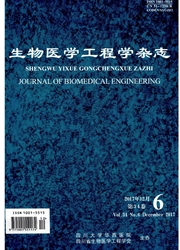

 中文摘要:
中文摘要:
本文提出一种基于左心辅助的血液循环系统控制模型,该模型由左心血液循环系统和旋转式心脏泵模型耦合而成。考虑心脏泵的水力特性,根据泵相似性原理提出了新型旋转式心脏泵的数学模型。泵模型耦合心血管系统后采用七阶集总参数非线性空间状态方程表示,控制变量为电机转速。本文采用泵心脏舒张期最小流量变化斜率作为反馈机制,确保最大灌注量的同时避免抽吸。通过Matlab对模型进行仿真,结果显示在开环控制下,心衰患者的血液循环系统各项血液动力特性均有改善。当转速为9 000 r/min时,经左心辅助的患者每搏心输出量由最初34 mL/s提高至正常水平82 mL/s,左心室压力-容积环向左偏移并且面积减小,说明辅助装置能够明显改善泵血不足并帮助心室卸载。若持续提高泵转速,当转速达到12 800 r/min时,会发生抽吸异常状况,这是因为转速过高导致静脉回流量不足而形成的。经采用反馈控制后,系统可有效避免抽吸现象。本文研究结果表明,基于左心辅助的血液循环系统的控制模型能在确保足量灌注量的同时避免抽吸异常状态。该模型反映了左心辅助装置与心血管系统的交互作用,为左心辅助心衰治疗和生理控制策略设计提供理论依据。
 英文摘要:
英文摘要:
We propose a control model of the cardiovascular system coupled with a rotary blood pump in the present paper. A new mathematical model of the rotary heart pump is presented considering the hydraulic characteristics and the similarity principle of pumps. A seven-order nonlinear spatial state equation adopting lumped parameter is used to describe the combined cardiovascular-pump model. Pump speed is used as the control variable. To achieve sufficient perfusion and to avoid suction, a feedback strategy based on minimum (diastolic) pump flow is used in the control model. The results showed that left ventricular assist device (LVAD) could improve hemodynamics of the cardiovascular system of the patient with heart failure in open loop. When rotation speed was 9,000 r/min, cardiac output reached 82 mL/s while the initial cardiac output was only 34 mL/s without the LVAD support. When the rotation speed was above 12 800 r/min, suction was found because the high rotating speed resulted in insufficient venous return volume. Suction was avoided by adopting the feedback control. The model reveals the interaction of LVAD and the cardiovascular system, which provides theoretical basis for the therapy of heart failure in the left ventricular and for the design of a physiological control strategy.
 同期刊论文项目
同期刊论文项目
 同项目期刊论文
同项目期刊论文
 期刊信息
期刊信息
